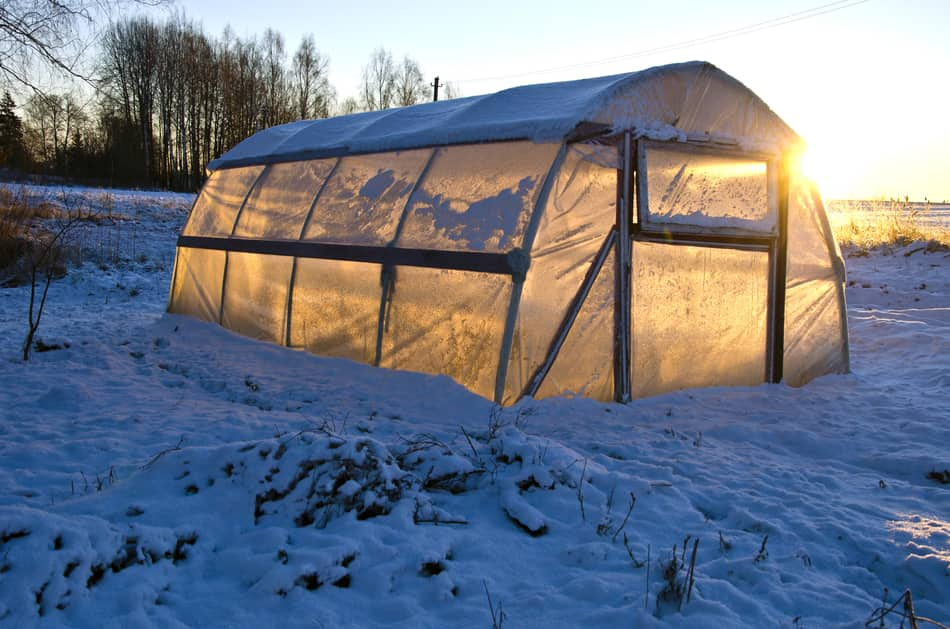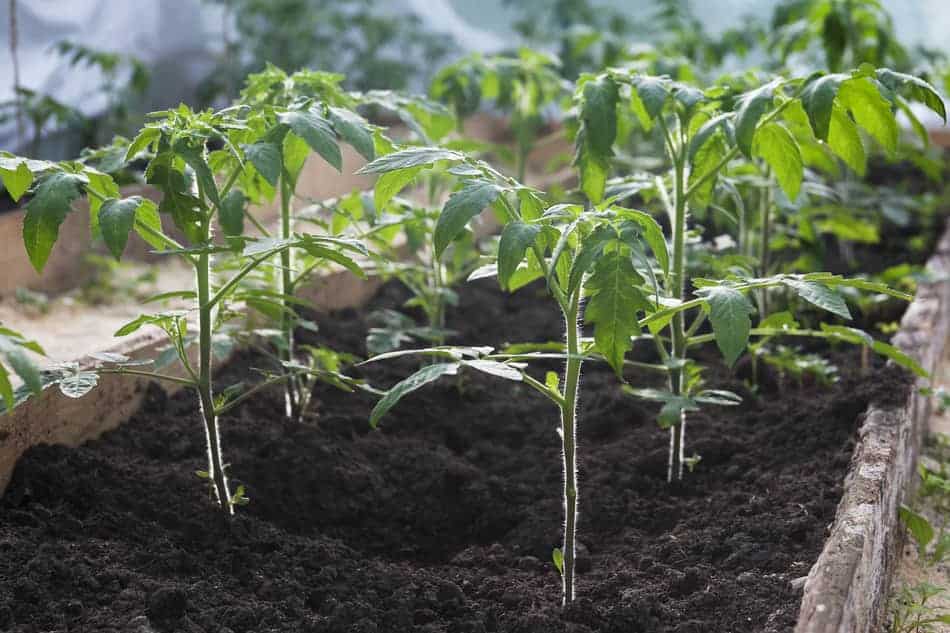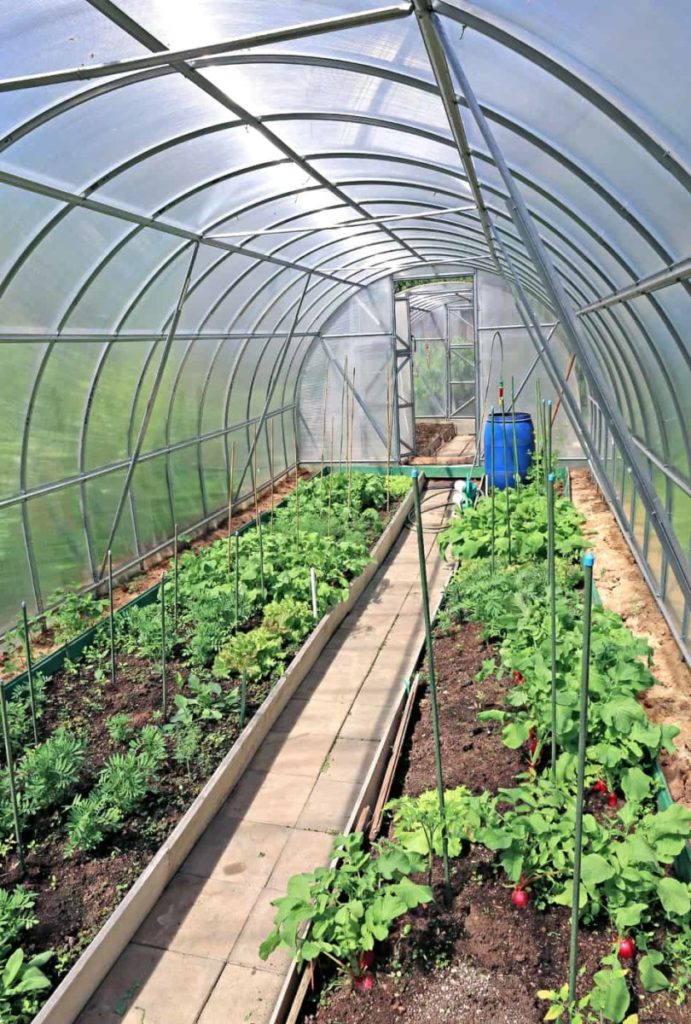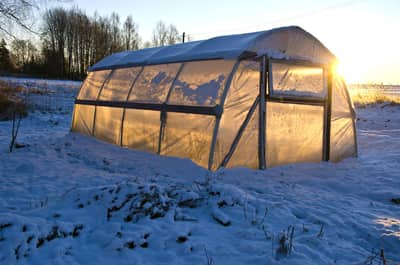If you’re like a lot of greenhouse growers, you want to extend the growing season, late into fall, early in spring, or even all through winter. Problem is, heating any building can be expensive–especially when you’re talking about a greenhouse that’s essentially a glass or plastic box which loses heat quickly.
The main ways to heat your greenhouse without electricity are: natural thermal masses such as water barrels or dark stones, as well as compost and even chickens. Depending on the size & indoor temperature needed, these methods–and good insulation–can heat a greenhouse.
You can also check out our guide: ways to heat your greenhouse for free.
 Winter greenhouse with snow – how to heat without electricity
Winter greenhouse with snow – how to heat without electricity
Background
Heating a greenhouse is important for a few reasons. For one thing, plants grow best when the day time temperature is between 70 and 80 degrees Fahrenheit. The next reason is that a greenhouse should act as an environmental control for your plants. The greenhouse should maintain a consistent temperature and humidity so that the plants do not get shocked by sudden changes in the temperature.
On average, a greenhouse costs $12,161 to build. This can fluctuate based on the size, materials used, and the design of the greenhouse. The bigger the greenhouse, the more it’ll cost.
Factors that affect heating costs
Also, depending on what you’ve built your greenhouse out of–like the 3 little pigs using straw, sticks, or bricks–different materials will retain heat more better than other materials.
And, the yearly cost to maintain your greenhouse will vary widely, depending on factors like:
- the size of your greenhouse (primarily square footage),
- glazing materials,
- insulation,
- your local climate & how cold it gets in your area,
- how warm you need your greenhouse to get compared to outside temperatures,
- whether you require supplemental heating & cooling,
- electricity needed, and
- water requirements.
For example, to cost to heat a relatively modest-sized greenhouse–say, just 1,000 square feet–might range between $0 – $1,000 per month. Again, the cost will vary greatly, depending on the factors above.
But, even looking at the middle of that range–$500 per month–simply to heat your greenhouse. That’s pretty pricey. So, naturally, you start thinking about ways to cut that cost.
How?
How to cut greenhouse heating costs
By insulating your greenhouse, using thermal mass and compost, solar power, and other techniques you can cut that price.
Insulation holds onto the heat you already have, and should be your first strategy. We’ve got a comprehensive guide on how to insulate your greenhouse.
The basic materials you can use for insulation are bubble wrap, polyethylene, fiberglass, and polycarbonates.
As for heating the greenhouse–without electricity–you can use thermal mass, solar panels, and compost.
 Tomato seedlings in a winter greenhouse
Tomato seedlings in a winter greenhouse
How warm should your greenhouse be?
There are some calculations you can do to determine the amount of heat you need in your greenhouse. One popular method is to take the surface area of the walls and the surface area of the roof, then multiply that area by the amount of heat loss the materials of the walls and roof have, also known as the U factor.
(SA of Walls + SA of Roof) × U Factor = amount of heat you need
That looks complicated, but essentially, the bigger your greenhouse, the more heat you’ll need to maintain a healthy, heated environment.
A simple rule of thumb
Typically, you should try to keep your greenhouse at 70 to 80 degrees if you want to grow plants year-round.
This may sound intimidating trying to keep your greenhouse that warm during the winter, but with the proper insulation the heat will be trapped in the greenhouse, and it’ll be easier than you think to keep it warm.
Here’s a guide for how warm to keep your greenhouse based on common plants:
- Tomatoes: 60-90 degrees
- Peppers: 65-95 degrees
- Lettuce: 50-60 degrees
- Carrots: 50-70 degrees
- Broccoli: 50-70 degrees
- Cucumbers: minimum of 60 degrees
- Eggplant: minimum of 60 degrees
- Oranges: 60-65 degrees
- Green beans: 60-70 degrees
How to use humidity to maintain temperature
While the temperature is important for the plants, humidity is also an important factor. Humidity helps maintain a temperature with less drastic fluctuations from day to night.
Basically, the mass of the extra moisture in the air acts a bit like a battery: storing heat during the day, and releasing it at night.
That way, more humidity minimizes wide temperature fluctuations.
And, by minimizing the fluctuation in temperature, your run less of a risk of shocking the plants and killing them.
Beware of too much humidity
However, there’s a downside from having too much humidity: it can make plants are more susceptible to diseases.
So, to reduce humidity, you’ll need to ventilate your greenhouse. During winter, this can be tricky, since you want to hold on to the heat you already have.
Wait, what? Isn’t that like keeping my windows open in my house during winter?
Well, sort of. You won’t need to ventilate the greenhouse ALL the time–just when the humidity is high, like over 80-90%. Typically, that’ll be during the day, when it’s a bit warmer anyway.
To ventilate, use fans or install some vents that you can open manually so you can get rid of excess humidity only when you need it. Basically you need to move the air around and get rid of the extra humidity.
Insulating a greenhouse–hang on to the heat you already have:
Insulating a greenhouse is important for keeping the heat you already have and reducing the amount of electricity you need for your greenhouse. The most common ways to do this are to use:
- greenhouse plastic,
- bubble wrap, or
- glass.
Bubble wrap, especially greenhouse specific bubble wrap, is a great way of trapping heat and enhancing the heat from the sun.
When you insulate your greenhouse, make sure there are no gaps between insulation layers & edges.
Using two forms of insulation is also beneficial. For example, you can use plastic as the exterior and then bubble wrap in the interior.
Plastic for insulation will brittle and eventually break after cold conditions and typically lasts about 3 years. Typically, bubble wrap lasts maybe 1-2 years. Also, regular bubble wrap is less effective than bubble wrap made specifically for greenhouses. Greenhouse-specific bubble wrap lasts about 3 years or longer, since it’s made to withstand UV light from the sun.
Straw–specifically straw bales– can also provide great insulation, and have the additional benefit that they’re completely organic. They can even double as shelves, benches, and work tables.
 Plastic greenhouse with raised beds and seedlings in winter
Plastic greenhouse with raised beds and seedlings in winter
Ways to heat a greenhouse without electricity
Thermal mass
While insulation traps heat, thermal mass is the best way to create heat without using electricity. Essentially, thermal mass acts as a battery for heat: during warm periods–like during a sunny day–the thermal mass heats up; then, when it’s cooler–like at night–the mass slowly releases the stored heat.
Thermal mass can be in the form of water barrels, straw, stones, paving bricks, etc. Basically, anything that’s heavy and dark works best to capture, retain, and slowly release heat.
Water barrels have a higher heat capacity so when the greenhouse temperature drops the water barrels will let off some of their heat and reheat the greenhouse. The same is true for stones. Darker stones will heat up from the sun and provide a steady release of heat for your greenhouse. Straw can be used to cover the soil and insulate the soil so there is less loss of heat.
Of the thermal mass choices, water is the most important because it has a higher heat capacity. Straw is also important but more so as a form of insulation then thermal mass.
Compost
Compost is one of the best ways to generate heat. But a lot of growers would be surprised to know how hot a compost pile can get–nearly 160 degrees Fahrenheit!
So basically, compost is a passive way to generate BOTH heat AND fertile soil!
What is compost? It’s essentially the decomposition of organic materials such as leaves, egg shells, and other plant byproducts into nutrient rich soil. The decomposition process creates a significant amount of heat. The compost will continue to create heat until it is fully broken down into soil.
Using compost will benefit your greenhouse in more ways than providing a good source of heat. When it’s finished decomposing, you’ll have nutrient-rich soil for your greenhouse.
Solar panels
Depending on your climate & region, solar panels can be a great way to create heat for your greenhouse without using any electricity. Solar panels take the energy from the sun and use this energy as electricity. The downside of solar panels is that they are expensive to install, don’t store energy (unless you have a battery system), and are only effective if they have access to the sun.
Paraffin heaters
Paraffin heaters are another, cheaper, good option to heat your greenhouse without electricity. These heaters run off fuel which is often a cheaper method than electricity. Another benefit of these is that they produce carbon dioxide which your plants need for photosynthesis.
When using these, make sure that you do not light them and forget to turn them off, since excess carbon dioxide and humidity can build up; adequate ventilation is needed.
Chickens
The next idea is to use chickens.
Wait–what?
Chickens to heat a greenhouse?!
I know, it might sound a little crazy, but chickens really can heat a greenhouse.
This has two benefits: one for the plants, and one for the chickens. The chickens produce body heat and carbon dioxide, which is beneficial to the plants.
Chickens also eat insects that may be affecting your plants. The greenhouse benefits the chickens, because it helps them produce more eggs in a safe environment.
Related questions
Do you need to heat a greenhouse in the winter?
If you want your plants to grow and produce fruits and vegetables then you need a greenhouse. There are plants that can endure the cold but they will not be productive if they are cold.
What temperature should a greenhouse be in the winter?
Greenhouses should be between 70 and 80 degrees in the day in the winter and can be lower at night, around 60 to 70.
What can you plant in a greenhouse in the winter?
You can plant many plants in a greenhouse in winter! Tomatoes, peppers, leafy greens, herbs, potatoes, carrots, you name it. Just monitor their output and the temperature of the greenhouse.
How do you cover plants in the winter?
You can cover plants with bubble wrap, plastic sheets, plastic bottles, and straw.

